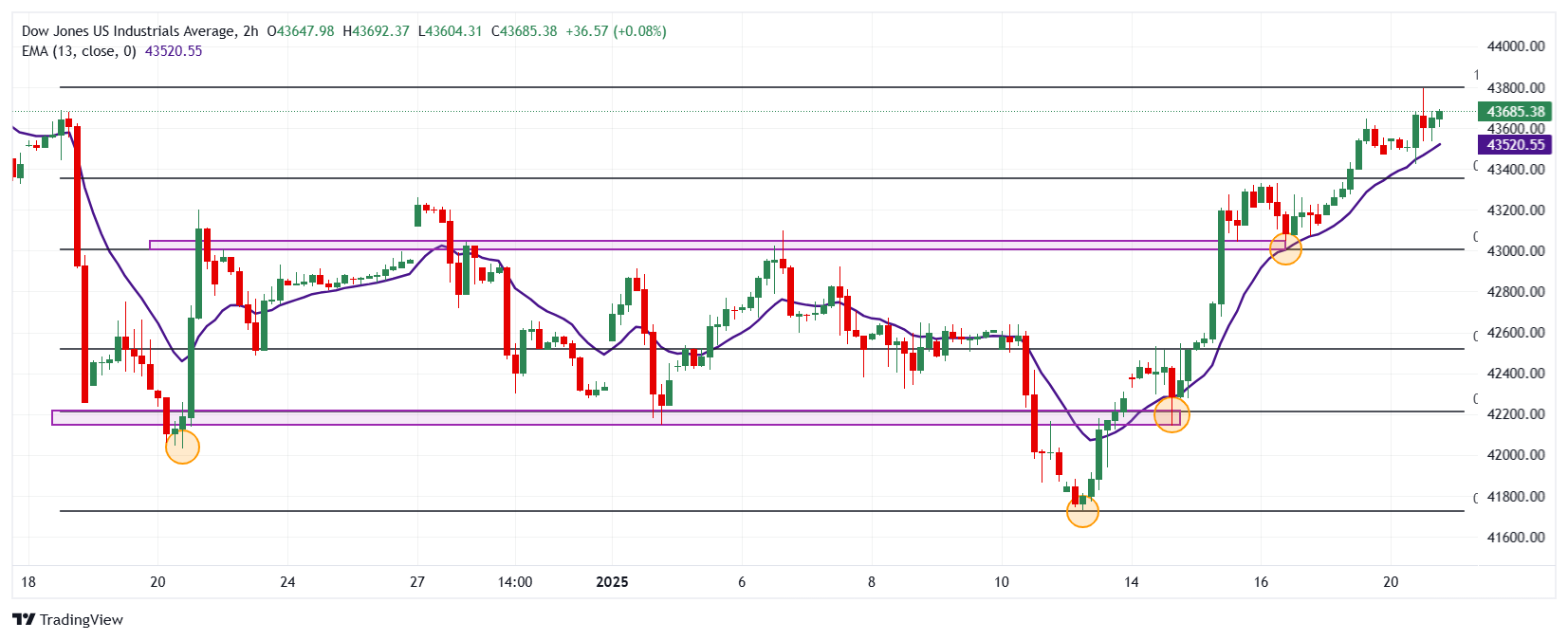- The Dow Jones advances 0.37% today.
- The Nasdaq 100 rises 0.38%, in a session with little volume.
- The S&P 500 gains 0.44% amid Trump’s inauguration.
The Dow Jones set a daily low at 43,424, finding buyers that took the index to a December 16 high of 43,796.
The Dow Jones Industrial Average opened at 43,541, while the Nasdaq 100 technology index began the day at 21,490. The S&P 500 opened trading at 6,002, extending gains ahead of Donald Trump’s inauguration.
The Dow Jones pauses to commemorate Martin Luther King
The Dow Jones index is currently trading at 43,631, up 0.37% on Monday.
Stock markets present a limited session in observance of Martin Luther King Day, signing their second consecutive session on the rise and extending last week’s gains. In a week in which the political and economic path of the United States will be defined, investors will be attentive to the quarterly report of 3M (MMM) tomorrow, where revenues of 5.78 million dollars and an earnings per share of 1.67 are projected. $ per share.
Nasdaq 100 posts marginal gains ahead of key financial reports
The Nasdaq 100 technology index rises 0.38% on the day, trading above 21,523, reaching January 6 highs of 21,626.
Traders will focus tomorrow when Netflix (NFLX) publishes its earnings at the close of the American session. The consensus expects revenue of $10.13 billion and earnings per share of $4.2. Similarly, Intuitive Surgical (ISRG) will release its quarterly report on Wednesday, January 22, as the market projects revenue of $2.2 billion and earnings per share of $1.75.
The S&P 500 remains in positive territory amid Donald Trump’s inauguration
The S&P 500 index rises 0.44% today, visiting highs not seen since December 18, 2024.
In the middle of a formal ceremony at the Capitol, Donald Trump has been sworn in as the 47th president of the United States, emphasizing in his first speech on establishing a series of tariff increases on his main trading partners, although without giving specific details.
The main stock indices register marginal gains today, with the focus on the quarterly reports of companies such as Verizon, Netflix, Prologis, Johnson & Johnson and Procter & Gamble.
Technical analysis of the Dow Jones
The Dow Jones established short-term support given by the January 14 low at 42,141. The next key support zone is at 41,731, the January 13 pivot point. To the north, the closest resistance is seen at 44,469, the maximum of December 10, 2024.
Dow Jones 2-hour chart

Dow Jones FAQs
The Dow Jones Industrial Average, one of the world’s oldest stock indices, is made up of the 30 most traded securities in the United States. The index is weighted by price rather than capitalization. It is calculated by adding the prices of the securities that comprise it and dividing them by a factor, currently 0.152. The index was founded by Charles Dow, also founder of the Wall Street Journal. In recent years it has been criticized for not being sufficiently representative, since it only follows 30 companies, unlike broader indices such as the S& P 500.
There are many factors that drive the Dow Jones Industrial Average (DJIA). The main one is the aggregate performance of its component companies, revealed in quarterly corporate earnings reports. US and global macroeconomic data also contribute, influencing investor sentiment. The level of interest rates, set by the Federal Reserve (Fed), also influences the DJIA, as it affects the cost of credit, on which many companies largely depend. Therefore, inflation can be a determining factor, as well as other parameters that influence the Federal Reserve’s decisions.
The Dow Theory is a method for identifying the main trend of the stock market developed by Charles Dow. A key step is to compare the direction of the Dow Jones Industrial Average (DJIA) and the Dow Jones Transportation Average (DJTA) and only follow trends where both are moving in the same direction. Volume is a confirmation criterion. The theory uses elements of maximum and minimum analysis. The Dow theory proposes three phases of the trend: accumulation, when the smart money begins to buy or sell; public participation, when the general public joins the trend; and distribution, when the smart money abandons the trend.
There are several ways to trade the DJIA. One of them is to use ETFs that allow investors to trade the DJIA as a single security, instead of having to buy shares of the 30 companies that comprise it. A notable example is the SPDR Dow Jones Industrial Average ETF (DIA). Futures contracts on the DJIA allow traders to speculate on the future value of the index, and options provide the right, but not the obligation, to buy or sell the index at a predetermined price in the future. Mutual funds allow investors to purchase a portion of a diversified portfolio of DJIA securities, providing exposure to the global index.
Source: Fx Street
I am Joshua Winder, a senior-level journalist and editor at World Stock Market. I specialize in covering news related to the stock market and economic trends. With more than 8 years of experience in this field, I have become an expert in financial reporting.







